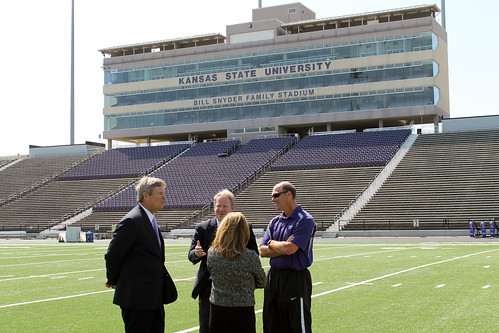
Yesterday, I celebrated USDA’s 150th Anniversary with the people of Manhattan, Kansas. For 150 years, USDA has supported the tremendous growth and success of American agriculture, conserved natural resources and built stronger communities and a stronger America. That legacy gives us a lot to be proud of.
In 1862, the same year that President Lincoln signed into law an act of Congress establishing the Department of Agriculture, the Morrill Act established the public Land-Grant Universities to teach agriculture and engineering. As the first Land-Grant University, Kansas State University continues impacts the lives of thousands continues that original vision.
When I delivered the Landon Lecture yesterday, I noted the incredible contributions that American agriculture makes to the strength of this nation and the world. But agricultural is always changing. 150 years ago, about half of all Americans lived on farms, compared with about 2 percent today. So, it is our duty not only to keep agriculture strong, but to remind the 98 percent of Americans who don’t farm of the importance of our work.
USDA’s scientific research plays a critical role in touching the lives of every American: from the farm field, to the kitchen table, to the air we breathe. Since our founding, USDA scientists and research funding have supported farmers and ranchers who produce a safe and abundant food supply for our families.
To give an example, the important work done at the recently modernized Agricultural Research Service Wheat and Sorghum Milling Laboratory in Manhattan helps drive economic growth. This lab is currently collecting and testing wheat quality data for the hard winter wheat growing region during harvest in order to promote domestic and export sale of U.S. wheat. Studies have shown that every dollar invested in agricultural research returns over $20 to our economy.
Wind erosion is another important example. After the dust bowl of the 1930s, USDA responded not only through the creation of a new agency – the Soil Conservation Service, now NRCS – but by conducting research on other tools we can use to conserve working lands. Today our soil is healthier and we have reduced erosion by more than 40% in the last 30 years alone. That impacts the productivity of our farmers and ranchers and makes the food they produce more affordable for every American.
That is just one small way that USDA research impacts this nation every single day.
Two years after he founded USDA, in what would be his final annual message to the Congress, President Lincoln called USDA "The People’s Department.” Through our work on a host of issues including food, agriculture, economic development, science, and natural resource conservation, USDA still fulfills Lincoln’s vision. As we commemorate 150 years of accomplishments, USDA looks to continue providing a safe, ample food supply for our nation and the world.
